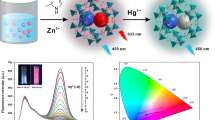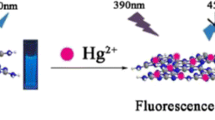Abstract
Carbon dots and gold nanoclusters co-encapsulated by zeolitic imidazolate framework-8 (CDs/AuNCs@ZIF-8) have been obtained at room temperature. The composite has been applied to the ratiometric fluorescence determination of mercury(II). The composite shows fluorescence emission maxima at 440 and 640 nm under 360 nm excitation, due to the CDs and AuNCs, respectively (associated quantum yields were 18% and 17%, respectively). In the presence of Hg2+, the fluorescence at about 640 nm is quenched, while the fluorescence at about 440 nm is unaffected. The CDs/AuNCs@ZIF-8 composite allows the sensitive detection of Hg2+, with the fluorescence intensity ratio (I640/I440) decreasing linearly with Hg2+ concentration over the range 3–30 nM. The fluorescence emission of the composite changes color from red to blue with increasing Hg2+ under UV excitation, which can easily be discerned visually. This visual detection of Hg2+ is due to the high fluorescence quantum yields of the CDs and AuNCs and the ~ 200 nm separation between the two emission maxima.

(A) Schematic diagram showing the operating principle of the determination for Hg(II). (B) Digital graph of the solutions in absence and presence of 30 nM Hg(II) under a portable UV lamp




Similar content being viewed by others
References
Erxleben H, Ruzicka J (2005) Atomic absorption spectroscopy for mercury, automated by sequential injection and miniaturized in lab-on-valve system. Anal Chem 77(16):5124–5128. https://doi.org/10.1021/ac058007s
Hong YS, Rifkin E, Bouwer EJ (2011) Combination of diffusive gradient in a thin film probe and IC-ICP-MS for the simultaneous determination of CH3Hg+ and Hg2+ in oxic water. Environ Sci Technol 45(15):6429–6436. https://doi.org/10.1021/es200398d
Zhang Z, Tang A, Liao S, Chen P, Wu Z, Shen G, Yu R (2011) Oligonucleotide probes applied for sensitive enzyme-amplified electrochemical assay of mercury(II) ions. Biosens Bioelectron 26(7):3320–3324. https://doi.org/10.1016/j.bios.2011.01.006
Sener G, Uzun L, Denizli A (2014) Lysine-promoted colorimetric response of gold nanoparticles: a simple assay for ultrasensitive mercury (II) detection. Anal Chem 86(1):514–520. https://doi.org/10.1021/ac403447a
Tyrakowski CM, Snee PT (2014) Ratiometric CdSe/ZnS quantum dot protein sensor. Anal Chem 86(5):2380–2386. https://doi.org/10.1021/ac4040357
Niu W, Shan D, Zhu R, Deng S, Cosnier S, Zhang X (2016) Dumbbell-shaped carbon quantum dots/AuNCs nanohybrid as an efficient ratiometric fluorescent probe for sensing cadmium (II) ions and l-ascorbic acid. Carbon 96:1034–1042. https://doi.org/10.1016/j.carbon.2015.10.051
Xie H, Dong J, Duan J, Waterhouse GIN, Hou J, Ai S (2018) Visual and ratiometric fluorescence detection of Hg2+ based on a dual-emission carbon dots-gold nanoclusters nanohybrid. Sensors Actuators B Chem 259:1082–1089. https://doi.org/10.1016/j.snb.2017.12.149
Wang L, Cao H, He Y, Pan C, Sun T, Zhang X, Wang C, Liang G (2019) Facile preparation of amino-carbon dots/gold nanoclusters FRET ratiometric fluorescent probe for sensing of Pb2+/Cu2+. Sensors Actuators B Chem 282:78–84. https://doi.org/10.1016/j.snb.2018.11.058
Wang R, Wang X, Sun Y (2017) Aminophenol-based carbon dots with dual wavelength fluorescence emission for determination of heparin. Microchim Acta 184:187–193. https://doi.org/10.1007/s00604-016-2009-y
Hua J, Jiao Y, Wang M, Yang Y (2018) Determination of norfloxacin or ciprofloxacin by carbon dots fluorescence enhancement using magnetic nanoparticles as adsorbent. Microchim Acta 185:137–145. https://doi.org/10.1007/s00604-018-2685-x
Cheng J, Xu YL, Zhou D (2019) Novel carbon quantum dots can serve as an excellent adjuvant for the gp85 protein vaccine against avian leukosis virus subgroup J in chickens. Poult Sci 98(11):5315–5320. https://doi.org/10.3382/ps/pez313
Chen T, Hu Y, Cen Y, Chu X, Lu Y (2013) A dual-emission fluorescent nanocomplex of gold-cluster-decorated silica particles for live cell imaging of highly reactive oxygen species. J Am Chem Soc 135(31):11595–11602. https://doi.org/10.1021/ja4035939
Zhou H, Long JR, Yaghi OM (2012) Introduction to metal-organic frameworks. Chem Rev 112(2):673–674. https://doi.org/10.1021/cr300014x
Park KS, Ni Z, Côté AP, Choi JY, Huang R, Uribe-Romo FJ, Chae HK, O’Keeffe M, Yaghi OM (2006) Exceptional chemical and thermal stability of zeolitic imidazolate frameworks. Proc Natl Acad Sci 103(27):10186–10191. https://doi.org/10.1073/pnas.0602439103
Liang K, Ricco R, Doherty CM, Styles MJ, Bell S, Kirby N, Mudie S, Haylock D, Hill AJ, Doonan CJ (2015) Biomimetic mineralization of metal-organic frameworks as protective coatings for biomacromolecules. Nat Commun 6:7240. https://doi.org/10.1038/ncomms8240
Chen W, Vázquez-González M, Zoabi A, Abu-Reziq R, Willner I (2018) Biocatalytic cascades driven by enzymes encapsulated in metal-organic framework nanoparticles. Nat Catal 1(9):689–695. https://doi.org/10.1038/s41929-018-0117-2
Selvaprakash K, Chen Y (2014) Using protein-encapsulated gold nanoclusters as photoluminescent sensing probes for biomolecules. Biosens Bioelectron 61:88–94. https://doi.org/10.1016/j.bios.2014.04.055
Song W, Liang R, Wang Y, Zhang L, Qiu J (2015) Green synthesis of peptide-templated gold nanoclusters as novel fluorescence probes for detecting protein kinase activity. Chem Commun 51(49):10006–10009. https://doi.org/10.1039/C5CC02280K
Wang L, Jiang X, Zhang M, Yang M, Liu Y-N (2017) In situ assembly of Au nanoclusters within protein hydrogel networks. Chem Asian J 12(18):2374–2378. https://doi.org/10.1002/asia.201700915
Xie J, Zheng Y, Ying JY (2009) Protein-directed synthesis of highly fluorescent gold nanoclusters. J Am Chem Soc 131(3):888–889. https://doi.org/10.1021/ja806804u
Xie J, Zheng Y, Ying JY (2010) Highly selective and ultrasensitive detection of Hg2+ based on fluorescence quenching of Au nanoclusters by Hg2+-Au+ interactions. Chem Commun 46(6):961–963. https://doi.org/10.1039/B920748A
Zhu S, Meng Q, Wang L, Zhang J, Song Y, Jin H, Zhang K, Sun H, Wang H, Yang B (2013) Highly photoluminescent carbon dots for multicolor patterning, sensors, and bioimaging. Angew Chem Int Edit 52(14):3953–3957. https://doi.org/10.1002/anie.201300519
Xu X, Yan B (2016) Fabrication and application of a ratiometric and colorimetric fluorescent probe for Hg2+ based on dual-emissive metal-organic framework hybrids with carbon dots and Eu3+. J Mater Chem C 4(7):1543–1549. https://doi.org/10.1039/C5TC04002G
Wu X, Ge J, Yang C, Hou M, Liu Z (2015) Facile synthesis of multiple enzyme-containing metal-organic frameworks in a biomolecule-friendly environment. Chem Commun 51(69):13408–13411. https://doi.org/10.1039/c5cc05136c
Ma Y, Xu G, Wei F, Cen Y, Xu X, Shi M, Cheng, Chai Y, Sohail M, Hu Q (2018) One-pot synthesis of a magnetic, ratiometric fluorescent nanoprobe by encapsulating Fe3O4 magnetic nanoparticles and dual-emissive rhodamine B modified carbon dots in metal-organic framework for enhanced HClO sensing. ACS Appl Mater Interfaces 10(24):20801–20805. https://doi.org/10.1021/acsami.8b05643
Hou J, Li J, Sun J, Ai S, Wang M (2014) Nitrogen-doped photoluminescent carbon nanospheres: green, simple synthesis via hair and application as a sensor for Hg2+ ions. RSC Adv 4(70):37342. https://doi.org/10.1039/c4ra04209c
Xiong H, Wang W, Liang J, Wen W, Zhang X, Wang S (2017) A convenient purification method for metal nanoclusters based on pH-induced aggregation and cyclic regeneration and its applications in fluorescent pH sensors. Sensors Actuators B Chem 239:988–992. https://doi.org/10.1016/j.snb.2016.08.114
Yan X, Li H, Jin R, Zhao X, Liu F, Lu G (2019) Sensitive sensing of enzyme-regulated biocatalytic reactions using gold nanoclusters-melanin-like polymer nanosystem. Sensors Actuators B Chem 279:281–288. https://doi.org/10.1016/j.snb.2018.10.009
Hou J, Dong J, Zhu H, Teng X, Ai S, Mang M (2015) A simple and sensitive fluorescent sensor for methyl parathion based on l-tyrosine methyl ester functionalized carbon dots. Biosens Bioelectron 68:20–26. https://doi.org/10.1016/j.bios.2014.12.037
Li B, Ma H, Zhang B, Qian J, Cao T, Feng H, Qin W (2019) Dually emitting carbon dots as fluorescent probes for ratiometric fluorescent sensing of pH values, mercury(II), chloride and Cr(VI) via different mechanisms. Microchim Acta 186(6):34. https://doi.org/10.1007/s00604-019-3437-2
Ke CB, Lu TL, Chen JL (2019) Excitation-independent dual emissions of carbon dots synthesized by plasma irradiation of ionic liquids: ratiometric fluorometric determination of norfloxacin and mercury(II). Microchim Acta 186(6):376. https://doi.org/10.1007/s00604-019-3505-7
Gao Y, Liu M, Yue X, Du J (2019) Ratiometric fluorometric determination of mercury(II) by exploiting its quenching effect on glutathione-stabilized and tetraphenylporphyrin modified gold nanoclusters. Microchim Acta 186(5):30. https://doi.org/10.1007/s00604-019-3405-x
Funding
This work was supported by the National Natural Science Foundation of China (41771342, 31872889), the Natural Science Foundation of Shandong Province, China (ZR2019MD025, ZR2017BB064), the Key R&D Program of Shandong Province, China (2018YYSP029), the “13th Five-Year” National Key R&D Program of China (2017YFD0801504), and the Funds of Shandong Double Tops Program, China (SYL2017XTTD01). GINW received funding support from the MacDiarmid Institute for Advanced Materials and Nanotechnology, the Dodd Walls Centre for Photonic and Quantum Technologies, and the Ministry of Business Innovation and Employment (MBIE) Catalyst Fund, Contract MAUX1609: “Disruptive Technologies from Metal-Organic Frameworks.”
Author information
Authors and Affiliations
Corresponding authors
Ethics declarations
Conflict of interest
The authors declare that they have no competing interests.
Additional information
Publisher’s note
Springer Nature remains neutral with regard to jurisdictional claims in published maps and institutional affiliations.
Manli Guo and Jingtian Chi are co-first authors.
Electronic supplementary material
ESM 1
(DOCX 1701 kb)
Rights and permissions
About this article
Cite this article
Guo, M., Chi, J., Li, Y. et al. Fluorometric determination of mercury(II) based on dual-emission metal-organic frameworks incorporating carbon dots and gold nanoclusters. Microchim Acta 187, 534 (2020). https://doi.org/10.1007/s00604-020-04508-z
Received:
Accepted:
Published:
DOI: https://doi.org/10.1007/s00604-020-04508-z




